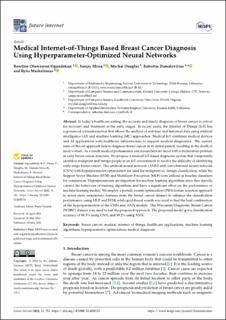| dc.contributor.author | Ogundokun, Roseline Oluwaseun | |
| dc.contributor.author | Misra, Sanjay | |
| dc.contributor.author | Douglas, Mychal | |
| dc.contributor.author | Damaševičius, Robertas | |
| dc.contributor.author | Maskeliunas, Rytis | |
| dc.date.accessioned | 2022-10-27T11:15:47Z | |
| dc.date.available | 2022-10-27T11:15:47Z | |
| dc.date.created | 2022-05-27T17:50:22Z | |
| dc.date.issued | 2022 | |
| dc.identifier.citation | Future Internet. 2022, 14 (5), Artikkel 153. | en_US |
| dc.identifier.issn | 1999-5903 | |
| dc.identifier.uri | https://hdl.handle.net/11250/3028623 | |
| dc.description.abstract | In today’s healthcare setting, the accurate and timely diagnosis of breast cancer is critical for recovery and treatment in the early stages. In recent years, the Internet of Things (IoT) has experienced a transformation that allows the analysis of real-time and historical data using artificial intelligence (AI) and machine learning (ML) approaches. Medical IoT combines medical devices and AI applications with healthcare infrastructure to support medical diagnostics. The current state-of-the-art approach fails to diagnose breast cancer in its initial period, resulting in the death of most women. As a result, medical professionals and researchers are faced with a tremendous problem in early breast cancer detection. We propose a medical IoT-based diagnostic system that competently identifies malignant and benign people in an IoT environment to resolve the difficulty of identifying early-stage breast cancer. The artificial neural network (ANN) and convolutional neural network (CNN) with hyperparameter optimization are used for malignant vs. benign classification, while the Support Vector Machine (SVM) and Multilayer Perceptron (MLP) were utilized as baseline classifiers for comparison. Hyperparameters are important for machine learning algorithms since they directly control the behaviors of training algorithms and have a significant effect on the performance of machine learning models. We employ a particle swarm optimization (PSO) feature selection approach to select more satisfactory features from the breast cancer dataset to enhance the classification performance using MLP and SVM, while grid-based search was used to find the best combination of the hyperparameters of the CNN and ANN models. The Wisconsin Diagnostic Breast Cancer (WDBC) dataset was used to test the proposed approach. The proposed model got a classification accuracy of 98.5% using CNN, and 99.2% using ANN. | en_US |
| dc.language.iso | eng | en_US |
| dc.publisher | MDPI | en_US |
| dc.rights | Navngivelse 4.0 Internasjonal | * |
| dc.rights.uri | http://creativecommons.org/licenses/by/4.0/deed.no | * |
| dc.subject | breast cancer | en_US |
| dc.subject | medical internet of things | en_US |
| dc.subject | healthcare applications | en_US |
| dc.subject | machine learning algorithms | en_US |
| dc.subject | hyperparameter optimization | en_US |
| dc.subject | medical diagnosis | en_US |
| dc.title | Medical Internet-of-Things Based Breast Cancer Diagnosis Using Hyperparameter-Optimized Neural Networks | en_US |
| dc.type | Peer reviewed | en_US |
| dc.type | Journal article | en_US |
| dc.description.version | publishedVersion | en_US |
| dc.rights.holder | © 2022 by the authors. | en_US |
| dc.subject.nsi | VDP::Teknologi: 500::Informasjons- og kommunikasjonsteknologi: 550 | en_US |
| dc.subject.nsi | VDP::Medisinske Fag: 700::Klinisk medisinske fag: 750::Onkologi: 762 | en_US |
| dc.source.volume | 14 | en_US |
| dc.source.journal | Future Internet | en_US |
| dc.source.issue | 5 | en_US |
| dc.identifier.doi | 10.3390/fi14050153 | |
| dc.identifier.cristin | 2027797 | |
| dc.source.articlenumber | 153 | en_US |
| cristin.ispublished | true | |
| cristin.fulltext | original | |
| cristin.qualitycode | 1 | |

